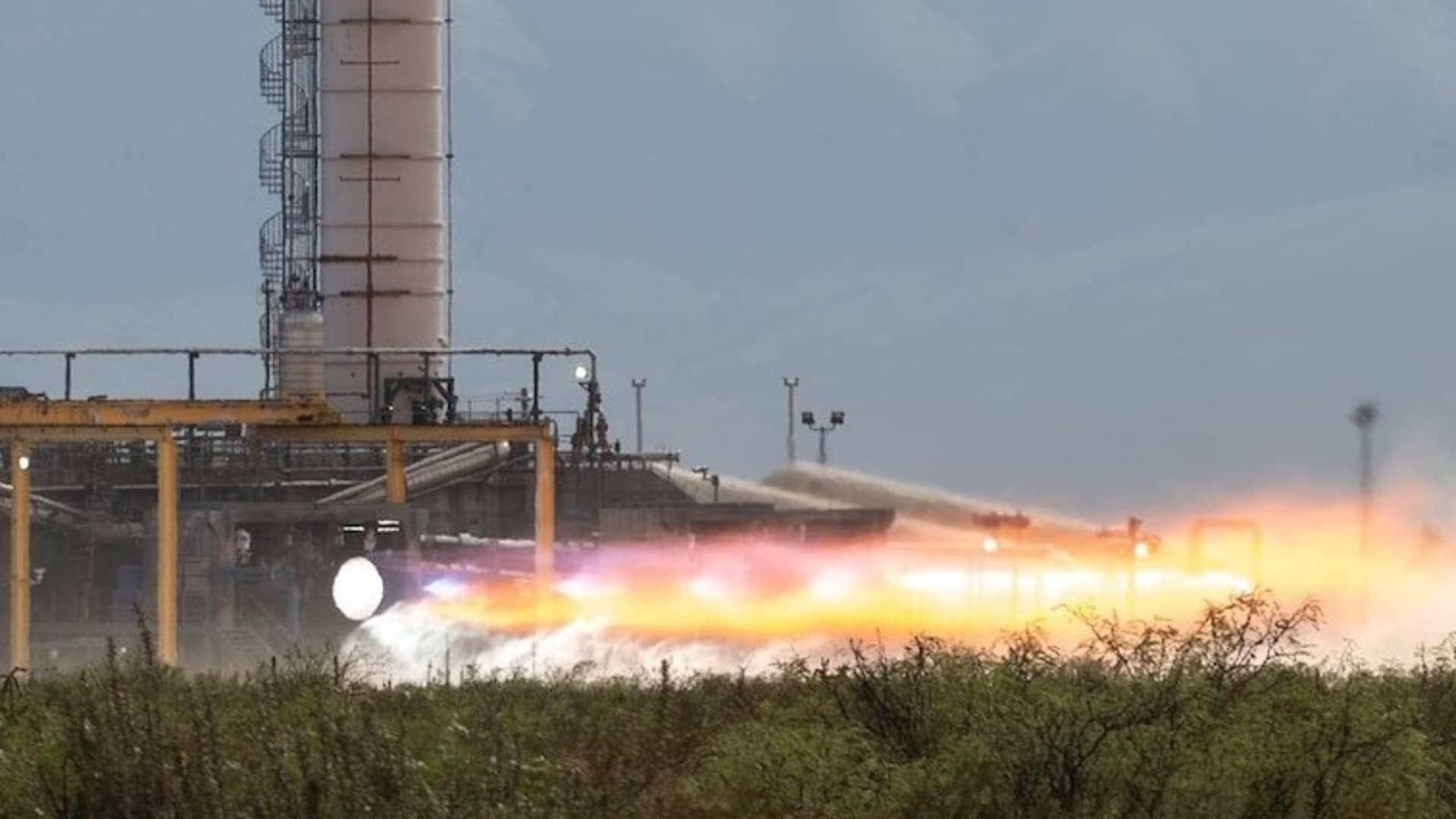A Blue Origin rocket engine exploded during testing last month, CNBC has learned, a destructive setback with potential ramifications for the company’s customers as well as its own rocket.
During a firing on June 30 at a West Texas facility of Jeff Bezos’ space company, a BE-4 engine detonated about 10 seconds into the test, according to several people familiar with the matter. Those people described having seen video of a dramatic explosion that destroyed the engine and heavily damaged the test stand infrastructure.
The people spoke to CNBC on the condition of anonymity to discuss nonpublic matters.
The engine that exploded was expected to finish testing in July. It was then scheduled to ship to Blue Origin’s customer United Launch Alliance for use on ULA’s second Vulcan rocket launch, those people said.
A Blue Origin spokesperson, in a statement to CNBC on Tuesday, confirmed that the company “ran into an issue while testing Vulcan’s Flight Engine 3.”
“No personnel were injured, and we are currently assessing root cause,” Blue Origin said, adding that “we already have proximate cause and are working on remedial actions.”
The company noted that it “immediately” made its customer ULA aware of the incident. ULA is the rocket-building joint venture of Boeing and Lockheed Martin, which competes primarily with Elon Musk’s SpaceX – especially going head-to-head over the most lucrative military launch contracts.
Blue Origin also said it will be able to “continue testing” engines in West Texas. The company previously built two stands for the tests.
“We will be able to meet our engine delivery commitments this year and stay ahead of our customer’s launch needs,” Blue Origin added.
Vulcan delays
BE-4’s test failure threatens to further push back the already delayed first Vulcan launch – which was recently rescheduled to the fourth quarter of this year – while Blue Origin examines the cause of the problem.
Each Vulcan rocket uses a pair of BE-4 engines to launch. ULA waited anxiously for years to receive delivery of the first set. A month ago, ULA completed a key milestone in preparation for the first Vulcan launch, known as “Cert-1,” with a short static fire test of the rocket using the first pair of BE-4 flight engines.
In a statement to CNBC, a ULA spokesperson said “the BE-4 testing issue is not expected to impact our plans for the Vulcan Cert-1 mission.” The company noted that the engines for Cert-1 “successfully passed acceptance testing” and are qualified to launch.
As ULA’s “Cert” mission name implies, the company needs to launch two Vulcans successfully to complete the U.S. Space Force’s certification of the rocket for operational flights. With ULA set to retire its currently operational rockets, Atlas V and Delta IV Heavy, the company needs Vulcan to be certified as soon as possible to begin flying national security missions.
Last month, Space Force assigned SpaceX and ULA each with six missions under the National Security Space Launch Phase 2 program. All six of ULA’s NSSL missions are set to fly on Vulcan. Additionally, ULA is preparing to bid for Phase 3 contracts under NSSL, with the Space Force welcoming heightened competition.
Blue Origin’s BE-4 incident comes after ULA spent three months investigating its own test explosion. In March, a separate part of the rocket – known as the upper stage – exploded during a structural test and required ULA to partially disassemble the first Vulcan rocket to reinforce the upper stage that was already installed.
While ULA determined the problem would be fairly easy to fix, it is now testing a change to the thickness of the upper stage’s steel walls to ensure the solution is sufficient before the company re-installs an improved version.
Blue Origin’s New Glenn
At the same time that Blue Origin needs to get BE-4 working well and humming off the production line for its main customer, the company also needs the engines for its own reusable New Glenn rocket that’s in development.
While Vulcan uses two BE-4 engines, each New Glenn rocket requires seven BE-4 engines – meaning Blue Origin needs to produce dozens a year to support both rockets.
Vulcan and New Glenn are both under contract to fly satellites for another Bezos-founded company, Amazon. The blockbuster commercial launch deal saw Amazon order 38 Vulcan launches and up to 27 New Glenn launches to fly its Project Kuiper internet satellites over the next few years.
Blue Origin also plans to use New Glenn to fly the lunar lander it’s developing under a $3.4 billion NASA contract.
BE-4, the centerpiece of Blue Origin’s stable of rocket engines, was supposed to be ready by 2017, but a myriad of development issues has meant the company only finished the first flight-ready engines recently.
Similarly, New Glenn was originally slated for its inaugural flight in 2020. But delays have changed that timeline to unknown, with Blue Origin leadership in recent public appearances declining to comment on a new debut launch target for New Glenn.
Blue Origin opened a major engine production factory in Huntsville, Alabama in 2020, and has expanded its facilities in the area to about 1 million square feet. NASA leased engine test stands at the Marshall Space Flight Center to Blue Origin. The company tests its smaller BE-7 lunar lander engine there, while restoring a larger NASA stand for BE-4 testing at its testing facility in Texas.
